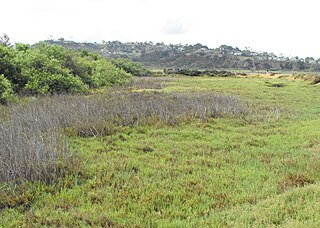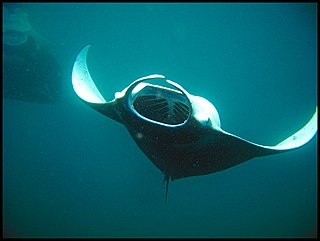
Seabirds are birds that are adapted to life within the marine environment. While seabirds vary greatly in lifestyle, behaviour and physiology, they often exhibit striking convergent evolution, as the same environmental problems and feeding niches have resulted in similar adaptations. The first seabirds evolved in the Cretaceous period, and modern seabird families emerged in the Paleogene.

Coral bleaching is the process when corals become white due to various stressors, such as changes in temperature, light, or nutrients. Bleaching occurs when coral polyps expel the zooxanthellae that live inside their tissue, causing the coral to turn white. The zooxanthellae are photosynthetic, and as the water temperature rises, they begin to produce reactive oxygen species. This is toxic to the coral, so the coral expels the zooxanthellae. Since the zooxanthellae produce the majority of coral colouration, the coral tissue becomes transparent, revealing the coral skeleton made of calcium carbonate. Most bleached corals appear bright white, but some are blue, yellow, or pink due to pigment proteins in the coral.

An apex predator, also known as a top predator, is a predator at the top of a food chain, without natural predators of its own.

The environmental impact of fishing includes issues such as the availability of fish, overfishing, fisheries, and fisheries management; as well as the impact of industrial fishing on other elements of the environment, such as bycatch. These issues are part of marine conservation, and are addressed in fisheries science programs. According to a 2019 FAO report, global production of fish, crustaceans, molluscs and other aquatic animals has continued to grow and reached 172.6 million tonnes in 2017, with an increase of 4.1 percent compared with 2016. There is a growing gap between the supply of fish and demand, due in part to world population growth.

Neuston, also called pleuston, are organisms that live at the surface of a body of water, such as an ocean, estuary, lake, river, or pond. Neuston can live on top of the water surface or may be attached to the underside of the water surface. They may also exist in the surface microlayer that forms between the top side and the underside. Neuston have been defined as "organisms living at the air/water interface of freshwater, estuarine, and marine habitats or referring to the biota on or directly below the water’s surface layer."

Brackish marshes develop from salt marshes where a significant freshwater influx dilutes the seawater to brackish levels of salinity. This commonly happens upstream from salt marshes by estuaries of coastal rivers or near the mouths of coastal rivers with heavy freshwater discharges in the conditions of low tidal ranges.
David Cameron Duffy is an American professor of botany and zoology at the University of Hawaiʻi, former Director of the Hawaiian Pacific Island Cooperative Ecosystem Studies Unit. and currently holds the Gerritt Parmele Wilder Chair in the School of Life Sciences at the University of Hawaiʻi Manoa.
When discussing population dynamics, behavioral ecology, and cell biology, recruitment is several different biological processes. In population dynamics, recruitment is the process by which new individuals are added to a population, whether by birth and maturation or by immigration. When discussing behavioral ecology and animal communication, recruitment is communication that is intended to add members of a group to specific tasks. Finally, when discussing cell biology, recruitment is the process by which cells are selected for certain tasks.

A planktivore is an aquatic organism that feeds on planktonic food, including zooplankton and phytoplankton. Planktivorous organisms encompass a range of some of the planet's smallest to largest multicellular animals in both the present day and in the past billion years; basking sharks and copepods are just two examples of giant and microscopic organisms that feed upon plankton. Planktivory can be an important mechanism of top-down control that contributes to trophic cascades in aquatic and marine systems. There is a tremendous diversity of feeding strategies and behaviors that planktivores utilize to capture prey. Some planktivores utilize tides and currents to migrate between estuaries and coastal waters; other aquatic planktivores reside in lakes or reservoirs where diverse assemblages of plankton are present, or migrate vertically in the water column searching for prey. Planktivore populations can impact the abundance and community composition of planktonic species through their predation pressure, and planktivore migrations facilitate nutrient transport between benthic and pelagic habitats.

The term stable isotope has a meaning similar to stable nuclide, but is preferably used when speaking of nuclides of a specific element. Hence, the plural form stable isotopes usually refers to isotopes of the same element. The relative abundance of such stable isotopes can be measured experimentally, yielding an isotope ratio that can be used as a research tool. Theoretically, such stable isotopes could include the radiogenic daughter products of radioactive decay, used in radiometric dating. However, the expression stable-isotope ratio is preferably used to refer to isotopes whose relative abundances are affected by isotope fractionation in nature. This field is termed stable isotope geochemistry.

Kelly Benoit-Bird is a marine scientist and senior scientist at the Monterey Bay Aquarium Research Institute. Benoit-Bird uses acoustics to study marine organisms and was named a MacArthur Fellow in 2010.

COASST is a citizen science project of the University of Washington, Seattle, WA, USA, with a goal of monitoring marine ecosystem health with the support of citizens within coastal communities. With the help of hundreds of volunteers, COASST assesses beach conditions and identifies and tracks any carcasses of dead seabirds found. Data on the carcass of a seabird contributes to the creation of a baseline record for the death rates of various species of seabirds, including which beaches birds are found at and in what density. Any irregularities can be identified and evaluated, so the cause of any increased mortality can be identified. COASST works with state, tribal, and federal agencies, environmental organizations, and community groups to help achieve their goals of monitoring and successfully establishing marine conservation solutions.
Erika S. Zavaleta is an American professor of ecology and evolutionary biology at the University of California, Santa Cruz. Zavaleta is recognized for her research focusing on topics including plant community ecology, conservation practices for terrestrial ecosystems, and impacts of community dynamics on ecosystem functions.

A marine coastal ecosystem is a marine ecosystem which occurs where the land meets the ocean. Marine coastal ecosystems include many very different types of marine habitats, each with their own characteristics and species composition. They are characterized by high levels of biodiversity and productivity.
The Fisheries and Marine Ecosystem Model Intercomparison Project (Fish-MIP) is a marine biology project to compare computer models of the impact of climate change on sea life. Founded in 2013 as part of the Inter-Sectoral Impact Model Intercomparison Project (ISIMIP), it was established to answer questions about the future of marine biodiversity, seafood supply, fisheries, and marine ecosystem functioning in the context of various climate change scenarios. It combines diverse marine ecosystem models from both the global and regional scale through a standardized protocol for ensemble modelling in an attempt to correct for any bias in the individual models that make up the ensemble. Fish-MIP's goal is to use this ensemble modelling to project a more robust picture of the future state of fisheries and marine ecosystems under the impacts of climate change, and ultimately to help inform fishing policy.
Joan Ann ("Joanie") Kleypas is a marine scientist known for her work on the impact of ocean acidification and climate change on coral reefs, and for advancing solutions to environmental problems caused by climate change.
Eileen E. Hofmann is a professor and eminent scholar at Old Dominion University who is known for her research linking biological and physical interactions in marine systems. In 2013, Hofmann was elected a fellow of the American Geophysical Union who cited her "for her pioneering work in modeling physical-biological interactions".
Claire Beatrix Paris-Limouzy, also known as Claire Paris, is marine scientist known for her research on fish larvae and tracking particles in the ocean. She also holds United States national records in freediving.
Alan Friedlander is an American marine ecologist and fisheries scientist focusing on protecting ocean habitats and incorporating traditional indigenous knowledge into contemporary conservation management. Friedlander was the lead author of the first study to describe inverted biomass pyramids in un-fished coral reef ecosystems. He has authored or contributed to over 400 publications, book chapters, and articles that have been cited over 15,000 times. As chief scientist for National Geographic's Pristine Seas Project, Friedlander has led over 40 expeditions resulting in the creation of 26 new marine reserves protecting more than 6.5 million square kilometers of remote and exceptional ocean habitats.
eOceans is an app and analytics platform for ocean organizations, stakeholders, and rightsholders to collaborate and get real-time insights on various aspects of the ocean and coastlines for informed, transparent, and timely decisions and actions.











